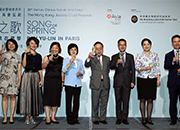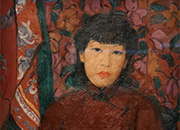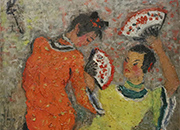

About HKJC
Jockey Club supports exhibition of exemplary painter Pan Yu-Lin’s work
09/11/2018
A pioneer in modernising Chinese art with western painting styles, Pan Yu-Lin (1895-1977) belonged to the first generation of Chinese students to study fine arts in France at a time when it was rare for women to achieve independent careers as professional artists. From tomorrow until 6 January, Hong Kong people will have a chance to learn more about Pan's sixty-plus works of painting and sculpture at a free exhibition entitled The Hong Kong Jockey Club Presents - Song of Spring: Pan Yu-Lin in Paris. It will be staged at the Asia Society Hong Kong (ASHK) Center in Admiralty. Funded exclusively by The Hong Kong Jockey Club Charities Trust, this exhibition is the first major presentation of Pan Yu-Lin in Hong Kong and the second instalment in the 20th Century Chinese Female Artist Series.
The Club's funding also covers The Jockey Club Art Education and Female Empowerment Series, allowing participants to understand the path of Pan's artistic development as a female role model of her era, and the endeavours of other women in art and different fields.
Today (11 September), the Club's Executive Director, Charities and Community, Leong Cheung joined the ASHK Center's Chairman Ronnie Chan and Executive Director Alice Mong, and Minister of Culture of Anhui Province Yuan Hua at the opening ceremony.
Mr Cheung said, "The Club has designated Arts, Culture and Heritage as one of its strategic focus areas, alongside Youth, the Elderly and Sports. We are dedicated to building a culturally vibrant Hong Kong, enriching lives and promoting social inclusion. "Mr Cheung added that the Club hoped to reach a wider audience through the works of Ms Pan, whose perseverance and determination in a difficult era for female artists eventually won her international recognition.
Born of humble origins, Pan seized the chance to be one of the first Chinese students to study fine arts in France. At the National School of Fine Arts in Paris, Pan was the first Asian student to win a scholarship to study at Accademia del Belle Arti di Roma, where she studied sculpture and painting. She returned to China in 1928 and was hired by the Shanghai Art Academy as the head of western painting. She also taught at the Nanjing Central University Fine Art Department from 1931 onwards, and remained as a researcher and tutor at the Shanghai Art Academy's painting research institute Yiyuan.
This exhibition explores Pan's unique trajectory and significance to modern Chinese art history by focusing on her second period in France, with over 60 works across four chambers dedicated to the themes of portraiture, nudes, cityscapes and landscapes. There are also dance figure paintings alongside archival materials and videos that delve into a comprehensive look at the art world of Pan Yu-Lin. The art works will come from the Anhui Province Museum in China, where some are categorised as Grade One Cultural Relics of China, and from the Cernuschi Museum in France. Over 25,000 people are expected to view the exhibition.
To enhance public understanding of Pan's work and contemporary art, The Jockey Club Art Education and Female Empowerment Series, running alongside the exhibition, will give participants the chance to understand more about her artistic journey and the stories behind other female role models.
The programme will include a series of public lectures related to Chinese female artists in the contemporary art world and the role of women in historic events. Some outstanding female leaders from different fields will be invited to share their experience of striving for success, for example Yip Wing Sie, Music Director of the Hong Kong Sinfonietta, and dance choreographer Mui Cheuk Yin.
Empowerment programmes will also be organised for children from underprivileged families and single-parent households, helping them build self-confidence, discover new personal capabilities and expand their problem solving skills.
The Club has long been a staunch supporter of the arts, and Arts, Culture and Heritage is one of four strategic focus areas of the Club's Charities Trust donations. The Central Police Station Revitalisation Project is one of its notable current initiatives, while the Asia Society Hong Kong Center, where the Pan Yu-lin exhibition is being held, itself occupies a Grade One historical structure whose restoration was funded by the Trust, The Hong Kong Jockey Club Former Explosives Magazine.
The Hong Kong Jockey Club
Founded in 1884, The Hong Kong Jockey Club is a world-class racing club that acts continuously for the betterment of our society. The Club has a unique integrated business model, comprising racing and racecourse entertainment, a membership club, responsible sports wagering and lottery, and charity and community contribution. Through this model, the Club generates economic and social value for the community and supports the Government in combatting illegal gambling. In 2017/18, the Club made a record return to the Government of HK$22.6 billion in duty and profits tax and contributed HK$1.2 billion to the Lotteries Fund. Approved charity donations were HK$4.2 billion. The Club is Hong Kong's largest single taxpayer and one of the city's major employers. Its Charities Trust is also one of the world's top ten charity donors. The Club is always "riding high together for a better future" with the people of Hong Kong.

Picture 1:
The Club’s Executive Director, Charities and Community, Leong Cheung says arts, culture & heritage is one of the strategic focus areas of the Club's Charities Trust.

Picture 2:
The Club’s Executive Director, Charities and Community, Leong Cheung (3rd right) joins the ASHK Center’s Chairman Ronnie Chan (4th right) and Executive Director Alice Mong (3rd left), Minister of Culture of Anhui Province Yuan Hua (4th left) and other guests at the opening ceremony of The Hong Kong Jockey Club Presents - Song of Spring: Pan Yu-Lin in Paris.



